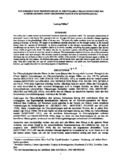[La reversión de un tipo de reacción fotoestable en fotolabiles en árboles de café causado por deficiencia de nitrógeno]
Description
10 fig. Bib. p. 10-14. Sum. (En)
Résumé
The coffee tree is under normal environmental conditions photically completely stable. The maximum concentration of chlorophyll occurs in the leaves fully exposed to the sun. Nitrogen deficiency causes in the plastids a change regarding their resistance to the photobiologic effect of the sun rays. The photically stable conditions turns into an unstable one, causing a chlorosis to develop. The degree of unstableness depends completely on the nitrogen concentration. Thus all types of unstableness can be found, from completely stable to extremely unstable, containing less green pigments than aureate forMON, which are genetically fixed. The reason why the sun rays have a greatly intensifying effect when the nitrogen concentration in the leaves is lower than normal is unknown. This phenomenon explains, however, why coffee plantations without shade need more nitrogen. The chlorosis caused by nitrogen deficiency is completely reversible if the nitrogen deficiency has not yet been so intensive as to affect the viability of the plastids. If nitrogen becomes again available, for instance during the rainy season, the chlorosis disppears and the leaves show agein the intensive green color of normal ones. Thus there exists but one type of constitutional photical resistance: the stable one. Environmental conditions, however, can modify this behavior and induce degrees of unstableness.
Éditeur
CATIE, Turrialba (Costa Rica)
URI
https://repositorio.catie.ac.cr/handle/11554/21http://orton.catie.ac.cr/repdoc/A6108o/A6108o.pdf
Collections
- Publicaciones y documentos [4189]


